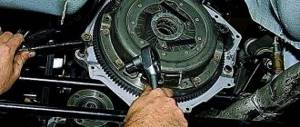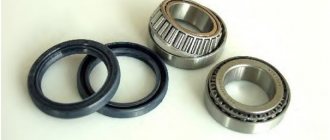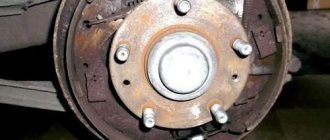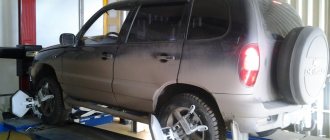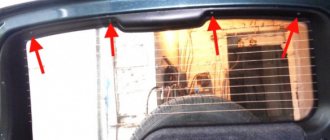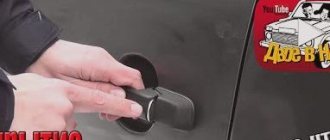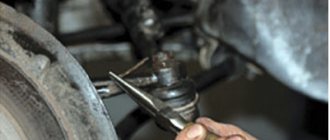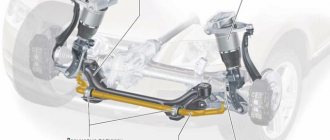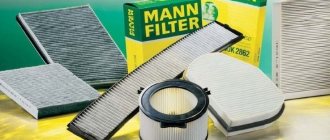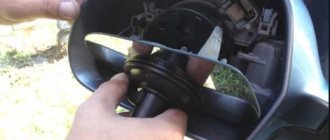Purpose and design
Rubber-metal hinges (silent blocks) are used to connect car suspension parts (levers, axles, rear suspension tie rods).
They dampen vibrations and shock loads that occur while driving. The parts are made in the form of a pair of bushings with an elastic insert between them.
There are two types of front arm silent blocks for Chevy Niva in stores. The first is typical for models released before 2008. Further, the design of the upper rubber-metal hinges has not changed, but the lower front ones have increased internal and external diameters by 2 and 7 mm, respectively. This made it possible to double the service life of parts.
Important: the upper silent blocks of the new and old model on the “Shniva” are interchangeable with the lower ones from the “classic”. When purchasing, you need to pay attention to the diameter of the lower Nivov joints.
What to do when a part is stuck?
The first signs of trouble can be detected early. To do this, unscrew the axle mounting nut with a 24 mm wrench, and then use a socket with a wrench to try to turn the bolt. If this cannot be done even with the elongated lever of the crank, then get ready for a lot of work - the axle is clearly stuck. In some, especially advanced cases, a stuck bolt does not even allow the spring to be released and pulled out.
There are several ways to solve the problem, but none of them are easy and will require from 1 to 5 hours depending on the degree of souring of the axle. Experienced owners of Niva 2121 practice the following method of dismantling the part:
- Using an angle grinder, cut off the axle on both sides to free the lower arm and remove it.
- Use a gas torch or blowtorch to heat up the part of the front beam with the bushing.
- Try to move the axle with strong blows of a hammer. If this was possible, but the end of the cut bolt was flattened, then you need to trim it again and knock out the part completely.
- If the bolt does not move, it is necessary to repeat the heating and cooling cycles several times. You can weld a crowbar to the cut-off part of the axle, with which you can try to turn it while warming up.
Also interesting: Changing the oil in the front and rear axles of a VAZ Niva
The described procedure usually takes 1-2 hours. If after this time you have not been able to move or rotate the steel rod, you need to move on to drastic methods:
- drilling a bolt from the sleeve with a hand drill;
- complete disassembly of the chassis and removal of the front beam.
The dismantled beam must be taken to the nearest car service center, where the rod will be pressed out with a press or drilled out on a machine.
Read news about the new Niva
- Clutch adjustment on Niva 21214 - Online reference book to help the car owner - looking for and fixing faults
- How to eliminate vibration of the VAZ-21213 transfer case
- Fuses and relays (location and purpose of fuses and relays) Niva Chevrolet "
- Mud tires for Niva 4x4: radius 15 and 16 - which one is better to install "
- Liquids used and filling volumes Niva VAZ 21213, 21214, 2131 lada 4×4
- Wheel stud M12x1.25x41 2121, 21213, 2131, 21214, 2123 rear
- Niva Chevrolet transfer case: device, connection diagram and how to use?
- How is a CV joint replaced on a Chevrolet Niva?
Which ones are better to choose?
The larger lower joints will not fit the front suspension arms and axles of vehicles built before 2008. Therefore, you can only choose the type of insert - classic (rubber) or new (polyurethane).
Advantages and disadvantages of polyurethane silent blocks
The use of polyurethane hinges has the following positive aspects:
- polyurethane wears off more slowly;
- the material does not dry out when heated;
- the polymer does not lose its properties under the influence of motor oil and other aggressive chemicals.
However, polyurethane silent blocks on the Chevrolet Niva have noticeable disadvantages:
- torsional loads occurring in the assembly quickly destroy the material (to prevent this from happening, a thicker layer of polyurethane is used in the new type of hinges);
- polyurethane silent blocks are much more expensive than rubber ones (up to 5 times);
- low frost resistance - at temperatures below -20 degrees the material becomes hard and often breaks when twisted.
Therefore, it is impossible to say for sure which hinges are best suited for your car. It all depends on the operating conditions and the mounting design of the lower front arms.
Mitsubishi MB633820 for Shniva
Mitsubishi upper silent blocks are deservedly considered one of the best polyurethane hinges.
A world-famous manufacturer managed to take into account the physical characteristics of the polymer and introduced frost-resistant parts to the market, so MB633820 is the best silent block for those who spare no expense on comfort and safety of movement.
Instructions for installing new silent blocks
Replacement of parts on a Chevrolet Niva is carried out for the right and left levers according to the same instructions.
- Raise the car using a jack. Remove the wheel.
- Place a support under the lower arm.
- Using a jack, raise the lower arm or, conversely, lower the car slightly to increase the load on the suspension. It is best to use a second jack to fully compress the spring. This way you will achieve this effect faster.
- Install the tie down spring and then lower the second jack to relieve stress on the anti-roll bar.
- Release the lever from the stabilizer clamp.
- Remove the shock absorber mounting bolt from the eye, having first unscrewed it.
- Remove the three nuts that secure the ball joint to the arm.
- Remove the second jack and remove the spring. Unscrew the lower arm axle nut and use a spacer to knock out the axle.
- Remove the lever. Pay attention to the location of the front suspension axle shims. Try to remember their number so that there are no problems when reassembling.
- Remove the nuts from the upper arm axis. Remove them along with the washers.
- Using a puller, press the old parts out of the lever lugs. If this cannot be done with a tool, then you need to use a blowtorch or gas torch. Clean the seat.
- Install new silent blocks and press them with the same tool. Before this, it is advisable to coat the lever and bushing with graphite lubricant, Litol or Movil.
Now you need to install the lever in place, making sure to place the shims correctly. Before you install this part, you can change the silent blocks on the upper arm. This operation is carried out according to simpler instructions:
- Tie the front hub together with the caliper to the body so as not to break the brake hose during the work.
- Remove the upper arm by unscrewing the bolts securing the axle and arm to the ball joint.
The rest of the work follows the same principles as when installing parts on the lower arm. First, the worn bushing is removed with a puller, and then a new one is installed in its place. Don't forget to clean the seat of the upper assembly and treat it with lubricant. After installing this part of the suspension, carry out final assembly.
The final tightening of the silent blocks should only be carried out with the machine standing on the ground. The Niva manufacturer recommends tightening the lower axle nut with a force of 100-170 N. After replacing the components on both sides, it is recommended to have a wheel alignment performed at a service station. This will help increase the life of the suspension and tires.
Replacement
To carry out the work you will need a garage with a pit, as well as a standard set of tools.
Required tools and materials
First of all, you need to stock up on new silent blocks. It is also recommended to buy bolts and nuts for securing the arms so as not to use old ones.
Materials and tools you will need:
- WD-40 product;
- ½" and 1/4" collars;
- open-end wrenches and heads from 13 to 24;
- strong wrench and pipe to increase torque;
- bottle type jack;
- puller;
- chisel;
- hammer.
Replacement procedure
The work is performed sequentially for the right and left front levers in the following order:
1. Raise the car on a jack and remove the wheel. 2. Place a support under the lower arm; 3. Raise the lower arm with a jack or lower the car slightly to load the suspension; 4. Unscrew the nuts of the bolts that secure the ball joint to the upper arm (3 pieces)
5. Unscrew the nuts of the bolts that secure the upper arm axle to the front suspension cross member bracket. 6. Remove the arm, and be sure to pay attention to the adjusting washers installed on the axle mounting bolts, remember their location and quantity;
7. Unscrew the nuts securing the upper arm axle; 8. Next, remove the nuts and washers from the axle;
9. Press out the old silent blocks from the lever lugs using a special puller;
10. Press in new silent blocks
Assembly of the unit is performed in the reverse order of disassembly.
Important! The silent blocks need to be finally tightened after the car is removed from the jack.
Replacing the lower silent blocks
In addition to hanging the car, removing the wheel, disconnecting it from the lower ball joint, remove the shock absorber from the lower mounting to the spring cup.
Disconnect the stabilizer clip from the link.
Lower the lever and pull out the spring.
After securing the lever axis with a 19 mm wrench, unscrew the 24 mm nut and remove the washer.
Carefully knock out the axle using a metal rod.
Remove the thrust washers.
Remove the lower arm; do not remove the spring cup.
Using a puller or a heavy hammer, press out the silent block.
Replacing the silent blocks of the front and rear levers with new ones is carried out in a similar manner to the disassembly process. For pressing, use a puller or tool head.
Perform final tightening and adjustment with the machine on its wheels. At the end of the process, do not forget to visit the stand to adjust the wheel alignment parameters.
Lifting rules
Increasing clearance is a labor-intensive procedure. It requires special skills and tools. Therefore, lifting is usually performed at a service station. However, if you have the skills, you can install the elevator kit yourself. In this case, it is necessary to pay attention to the following points:
- Lifting requires an integrated approach. Simultaneously with the increase in ground clearance, it is necessary to change the shock absorbers and thrust rods. Otherwise, the suspension lift will make the car unusable.
- On the right side of the rear of the body there is a gas tank with ventilation pipes. This must be taken into account if, in addition to lifting, you decide to enlarge the wheel arches.
- If there is a significant change in ground clearance, you should install an extended brake hose and adjust the bump stops. You will also have to reconfigure the pressure regulator in the rear brake circuit.
For tuning at home, it is better to use ready-made factory-made lift kits.
Installation of wheels with a large outer radius. In this case, the craftsmen are faced with a limitation - tires that are too large do not fit into the wheel arches. You have to widen them or move the wheel outside the car, installing extended hubs.
Installation of spacers. This method allows you to slightly raise the body and does not require much labor.
Installation of larger springs. This method is more expensive, but allows you to achieve a greater lifting height of the body.
Installation of wheel reducers on the rear axle. These parts allow the hubs to be lowered and increase the distance from the axle to the ground.
Also interesting: How to properly use the transfer case on Niva 2121
Downward displacement of the front beam. To do this, you will have to weld special fasteners onto the side members and install extended arms.
Installation of extended springs and spacers under ball joints. A simple and inexpensive way to greatly increase ground clearance.
Silent blocks Niva Chevrolet. Resolving issues.
There were three problems with old-style silent blocks. Quality, design miscalculation and lack of alternative (polyurethane option). Let's consider these options in order.
- Quality. The situation has changed greatly in a positive direction. The lower silent blocks for conveyor machines are supplied by the joint venture Anvis Group, and the quality of their rubber-metal products is assessed by the services as quite high.
- Design. Because the restyled design has been significantly strengthened. The knot has become much stronger “in terms of time between failures”. Of course, I won’t say that it has become like silent blocks from Mercedes or Isuzu, the size of a tea cup, but it works. And you can feel it that the new suspension is different from the old one. Especially if you change from car to car. The service life of the lower silent blocks has more than doubled. There was more “meat” in the joint and it was able to work at large angles without destroying the rubber mass. Let's remember the analogy with Napoleon cake.
- Alternative material. In this design, it became possible to use silent blocks made of polyurethane. Cars with them have already traveled more than tens of thousands of kilometers and we can draw a very definite conclusion. It works. True, there is still one limitation, but that is in the next chapter.
